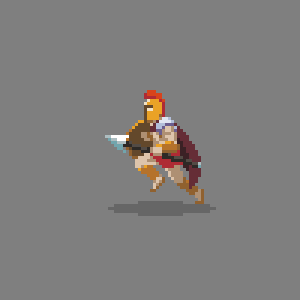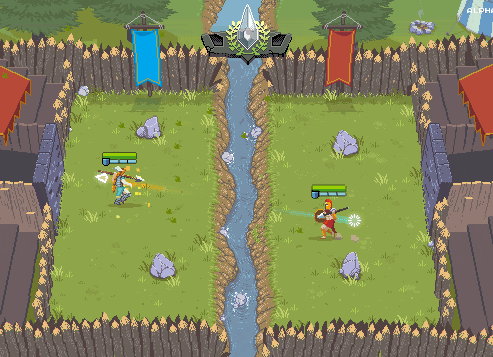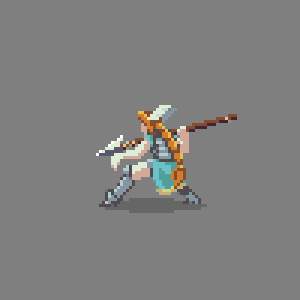It’s time for an interview with the true indie developers. We’ve talked to Tiago Franco from a two men studio Fun Punch Games about how do you become an indie. And why.

First, please tell us a few words about yourself.
We are a team of 2 indie game developers from Lisbon, Portugal. We met in highschool about 11 years ago.
I, Tiago, do the art and animation. I remember making tabletop and card games for my friends and family when I was a kid and experimenting with RPG Maker 2000 later on, as a teenager. I pursued a degree in Multimedia Design and ended up becoming a web designer. Jumping into game jams, in my free time, as a 2D artist and animator taught me very valuable lessons about game dev and a brought back the will to pursue a videogame development career. Filipe had a much more unorthodox career path. He was going for an architecture and urbanism degree before feeling out of place about his choice in its 4th year of college and dropped out. He then started to develop an interest in programming. Being passionate about video games, he began to experiment with a few small projects using Flash. We lived together for a few months and what was already a great friendship easily became a solid team with plenty of ideas. One of them was Strikers Edge.
So far we still have full-time jobs, I still work as a web designer, Filipe as a developer, but we plan to make the jump to full-time game developers and finish Strikers Edge.

Why did you enter the indie scene?
We both play a lot of videogames, since a young age. We discuss videogames all the time, we often throw game ideas at each other. I used to write about videogames as well, and always wanted to do something videogame related. There aren’t many “traditional” game development career opportunities here in Portugal, it’s a long shot if you want to become a professional in the area, so we went for safer careers and a few game jams until now that we got more knowledge and a “plan-B”. We want to bring to life our own ideas, though, not a corporate guys idea following some market research, so we fell like developing our game independently is the best way.
Indie games are having a tough time now (some experts suggest that we are on the threshold of the new video game crash). What is the indie dev’s biggest problem right now from your point of view?
For us, standing out from the crowd is the hardest part. The markets offer is huge and it becomes hard to make your game interesting when there are so many other games competing for attention. Even if your games is amazing, it’s hard to get your audience. At the same time, prices tend to shrink and the market don’t value games as much. We’re afraid that Steam turns into the next the App Store/Google Play, where freemium is the go-to business model. Getting an audience and keeping your players is hard. Making a life out of it is even harder.

Please, tell us about your first game – Strikers Edge.
Strikers Edge is an intense multiplayer arcade arena combat game where you fight as an ancient warrior. Imagine dodge ball with real weapons and ancient warrior, from a valkyrie, to a spartan, to a barbarian, among other, each with its stats and abilities, across multiple arenas with various layouts, obstacles and powerups.
The game started out as a submission for Global Game Jam, a 48-hour game jam worldwide competition. We quickly realized its potential as a competitive game and how we could add more substance by building on top of the core mechanics we already had. We’ve been working on it on our spare time and hopefully, we’ll jump into full-time development soon. It’ll be available for PC, Mac and Linux and possibly consoles as well.
Today there are a lot of pixel games. But not so many of them are done right. You did it perfectly. Сan you tell us how do you draw, – i.e. what technics do you use?
Thank you! I don’t consider myself a professional artist nor pixel artist, but I draw a lot of inspiration from other pixel artist and games I admire. I’d say before diving into pixel art you should get familiar with the ‘art’ part first. In my process, I like to analyze retro games from an artistic and technical point of view. Then, working with that aesthetic, I try to bring something new only possible with today’s resources and technology. I don’t limit myself in terms of color count, for example, and we’re playing around with modern day visual effects to see how it can benefit the game. There are a few guidelines, though: Frame-by-frame animation helps sell the “retro” look. Keep the resolution low without compromising on gameplay. Scaling the graphics proportionately without antialiasing and respecting the pixel grid. Use the same pixel density across all your assets.

You’ve chosen an ancient setting for the game. Why so?
When it was just a prototype, the game featured two spearmen. It quickly became very clear that the game should be about ranged weapons combat. We started to list other throwing weapons and what kinds of warriors would use them. We had lots of ideas for characters, weapons, and abilities and decided to go with this ancient tone to keep consistency, as all characters seem to fit well in this ambient.
What instruments do you use in game development?
We use Photoshop for all pixel art and animation and Illustrator for vector based artwork. We then get everything together in Unity with C#. To keep everything in sync and backed up, we use Trello for task management, Google Docs for document and spreadsheet creation, Dropbox for file sharing, and git through Bitbucket for version control.
And the final question: when game is finished?
We hope to have it ready sometime this year.
